Every trip to Mangalore teaches me something new. Whether it is in the form of cooking tips, new recipes or simply lessons on life. Although I didn’t get a lot of time to learn new recipes this time around, I did manage to get some ingredients. The husband found some hog plums at the market and joyfully he brought some back. It has been a while since I cooked them. The last time I added them to vegetables was when I was in Mumbai. Since we found pretty much everything in the four bungalows market I never thought that someday I would miss something as simple as hog plums so much!
I have seen them come in two sizes. The small ones are what I grew up eating. They are hard and fibrous – not very fleshy. The second type is what I have used in this recipe – large and fleshy and so delicious!
It was during this trip that I tasted these hog plums in a curry. It was nice and tangy and tasted so much of the ripe mango curry that we usually prepared during the summer. Whoever developed this recipe perhaps loved the mango curry so much that he/she decided to replicate it using hog plums. After all it was important to keep the ideas rolling, especially during the long monsoon months when seafood was hard to come by. With large families to feed, mothers often served seasonal goodies in new avatars. An earthen pot of simmering hog plum curry would be a welcome sight if you visited Mangalorean homes during lunch time. This was served with piping hot ‘red rice’ (unpolished boiled rice), pickles and perhaps dry shrimp chutney – a complete budget meal.
Botanically called as the Spondias, the hog plums are also called as Indian mombin, Spanish plums, wild mango or golden apples but they are neither plums not mangoes nor apples. They actually belong to the cashew family. The Indian variety (spondias pinnata) is just one of the 17 species that are native to the Neotropics and tropical Asia.
Till the time I began to write this post I didn’t know about its amazing medicinal uses. The bark, roots, leaves and fruit of the tree are all used in the treatment of various diseases such as cholera, dysentery, stomach aches, rheumatism, swollen joints.
If you do manage to find the hog plums where you live, I strongly recommend you give this dish a try. If you wish you can reduce the amount of coconut used to make the curry more spicy and reddish in colour. It is recommended to prepare the hog plums (stew them in a jaggery and salt solution) at least 4-5 hours before cooking them as this will help them absorb the flavours. I prepared them a day in advance and placed them in the fridge.
If you manage to make this curry do let me know how you liked it. Write to me at ruchikrandhap@gmail.com. I’d love to hear from you!
Ambadyanchi Kadi
Prep time: 20 mins + 2 hours | Cook time: 5-7 mins | Serves 2-4
Ingredients:
- 4 large or 6 small hog plums (ambade) (approx 350 -400 grams)
- 2 cups (500ml) water
- 50 -75 grams jaggery, powdered
- 1 level teaspoon salt (adjust to taste)
For the masala:
- 4-5 long dry red chillies (preferably byadge), deseeded if you wish
- 2 teaspoons coriander seeds
- 1 teaspoon cumin seeds
- 3-4 peppercorns
- 1/8th teaspoon mustard
- 1/4 teaspoon turmeric
- 2 cloves of garlic
- 1 medium sized onion (1/2 to be roasted and the other half to be ground without roasting)
- 1/2 cup grated coconut, divided (1/4 cup to be roasted and 1/4 cup to be ground without roasting)
For tempering:
- 1/2 teaspoon mustard
- 2 teaspoons ghee or oil
Method:
1. Wash and lightly scrape (not peel) the exterior of the hog plums. Score them vertically (apply 3-4 vertical cuts).
2. Place them in a pan with 2 cups of water and salt and bring the mixture to a boil. Cook until tender – this could take anywhere between 5 mins (if you are using the large variety which are more tender and fleshy) to 15 mins (if you are using the small and hard, non fleshy variety).
3. Next, add the powdered jaggery and simmer for 7-8 minutes. Do a taste check and add some more. Don’t go overboard with the jaggery at this stage. You can always add more when you are actually making the curry.
4. Turn off the heat and let the hog plums cool down and absorb the flavours for at least 3-4 hours. For best results, once cooled transfer to the fridge and keep overnight.
5. To make the masala, heat a skillet/tawa on medium and dry roast each of these ingredients one by one – red chillies, coriander, cumin, peppercorns, mustard, garlic, half of the coconut and half of the onion. Let the roasted ingredients cool completely before grinding along with the turmeric and the remaining coconut and onion (the unroasted ones). Use water 1-2 tablespoons at a time to achieve a fine paste. Remove the masala and reserve the masala water from the mixie.
6. Bring the hog plums once again to a boil, reduce to simmer and add the ground masala paste to it – be careful to keep the heat on very low or else the coconut in the masala could curdle. Keep a spoon or ladle in the pan to help prevent this.
7. When the curry is simmering, do a final taste check – adjust the salt and jaggery if required. The more you simmer, the more accurate your taste check will be as the flavours that were absorbed by the hogplums will get released into the curry. If the curry begins to taste very tangy try balancing it with some salt or dilute the curry slightly with 2-3 tablespoons of water at a time. Once done, remove from heat
8. To temper, heat ghee in a small pan and toss in the mustard seeds. When they stop spluttering, pour the mixture into the prepared curry and immediately cover the pan to trap the aroma and flavours.
9. Serve hot with piping hot rice.
Sources:
3. Wild Mango
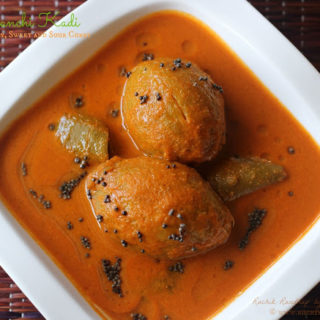
Ambadyanchi Kadi
An earthen pot of simmering hog plum curry would be a welcome sight if you visited Mangalorean homes during lunch time. Try this hog plum curry to experience the humble cuisine of Mangalore
Print
Pin
Rate
Ingredients
- 4 large or 6 small hog plums ambade (approx 350 -400 grams)
- 2 cups 500ml water
- 50 -75 grams jaggery powdered
- 1 level teaspoon salt adjust to taste
For the masala:
- 4-5 long dry red chillies preferably byadge, deseeded if you wish
- 2 teaspoons coriander seeds
- 1 teaspoon cumin seeds
- 3-4 peppercorns
- 1/8 th teaspoon mustard
- 1/4 teaspoon turmeric
- 2 cloves of garlic
- 1 medium sized onion 1/2 to be roasted and the other half to be ground without roasting
- 1/2 cup grated coconut divided (1/4 cup to be roasted and 1/4 cup to be ground without roasting)
For tempering:
- 1/2 teaspoon mustard
- 2 teaspoons ghee or oil
Instructions
- Wash and lightly scrape (not peel) the exterior of the hog plums. Score them vertically (apply 3-4 vertical cuts).
- Place them in a pan with 2 cups of water and salt and bring the mixture to a boil. Cook until tender – this could take anywhere between 5 mins (if you are using the large variety which are more tender and fleshy) to 15 mins (if you are using the small and hard, non fleshy variety).
- Next, add the powdered jaggery and simmer for 7-8 minutes. Do a taste check and add some more. Don’t go overboard with the jaggery at this stage. You can always add more when you are actually making the curry.
- Turn off the heat and let the hog plums cool down and absorb the flavours for at least 3-4 hours. For best results, once cooled transfer to the fridge and keep overnight.
- To make the masala, heat a skillet/tawa on medium and dry roast each of these ingredients one by one – red chillies, coriander, cumin, peppercorns, mustard, garlic, half of the coconut and half of the onion. Let the roasted ingredients cool completely before grinding along with the turmeric and the remaining coconut and onion (the unroasted ones). Use water 1-2 tablespoons at a time to achieve a fine paste. Remove the masala and reserve the masala water from the mixie.
- Bring the hog plums once again to a boil, reduce to simmer and add the ground masala paste to it – be careful to keep the heat on very low or else the coconut in the masala could curdle. Keep a spoon or ladle in the pan to help prevent this.
- When the curry is simmering, do a final taste check – adjust the salt and jaggery if required. The more you simmer, the more accurate your taste check will be as the flavours that were absorbed by the hogplums will get released into the curry. If the curry begins to taste very tangy try balancing it with some salt or dilute the curry slightly with 2-3 tablespoons of water at a time. Once done, remove from heat
- To temper, heat ghee in a small pan and toss in the mustard seeds. When they stop spluttering, pour the mixture into the prepared curry and immediately cover the pan to trap the aroma and flavours.
- Serve hot with piping hot rice.
Notes
Disclaimer
The nutritional values are only indicative.
Tried this recipe?Please leave a comment & rate the recipe below or share a photo on Instagram and tag me @ruchikrandhap
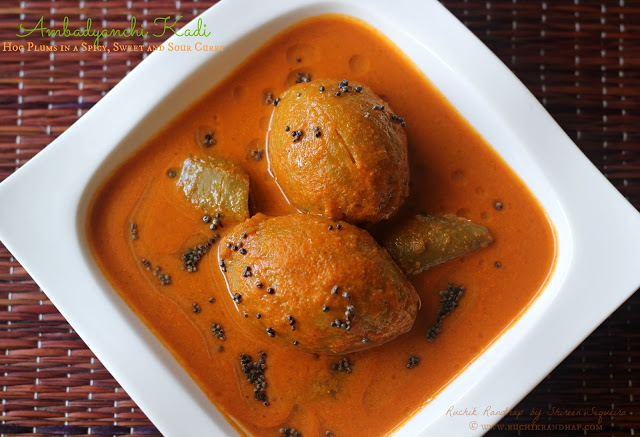

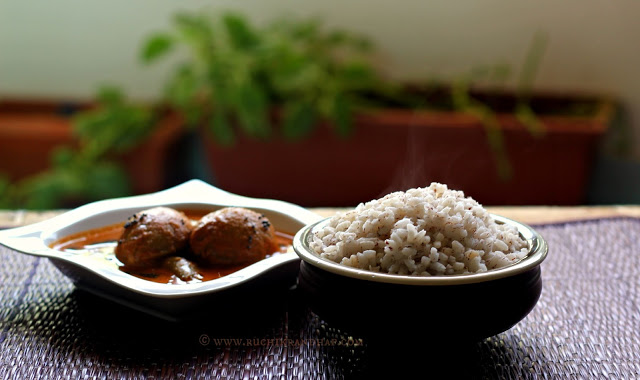
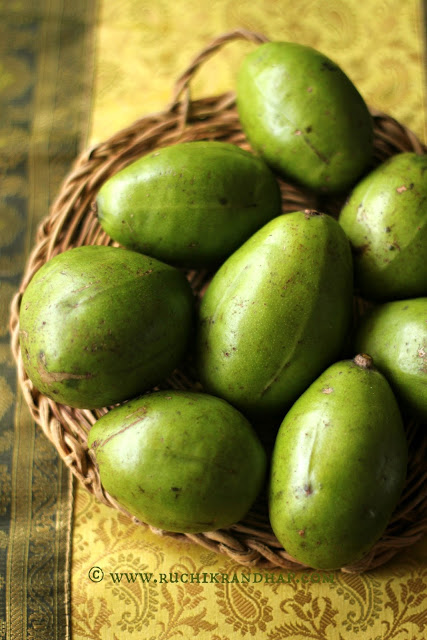
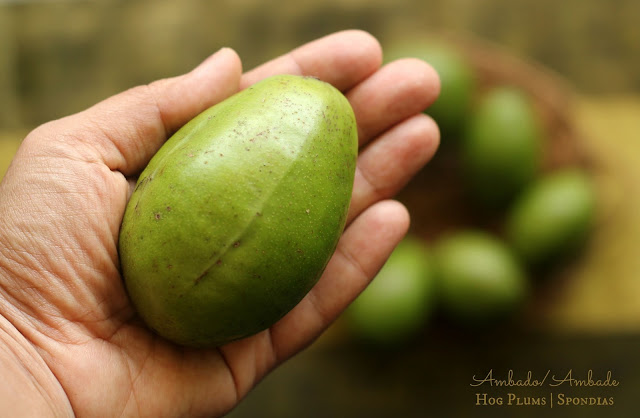
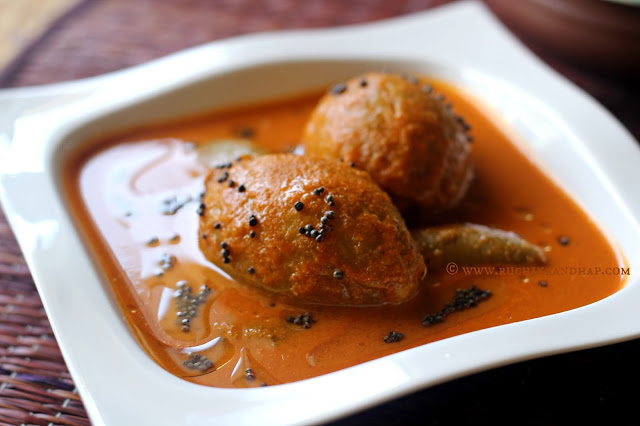
hi shireen, My family don't eat hog plums, but I liked the masala. Can u pl tell me for what veggie or veggie combination I cn use this masala for? thnk U.
I would be grateful if u could give us some veggie curry masalas and the veggie or their combnation that can be used.
@ Maria: You could try out this dish with potatoes or yam I'm guessing…you just need to experiment and see what works best for you! Good luck!
Do checkout my entire Veg recipe index above!
What you have as hog plum…
Spondias dulcis (syn. Spondias cytherea), known commonly as ambarella or pomme cythere or golden apple in Trinidad and Tobago,Dominica, Guadeloupe, Saint Lucia and Martinique,June plum in Bermuda and Jamaica,mangotín in Panama, juplon in Costa Rica, golden apple in Grenada, Barbados and Guyana, golden plum in Belize, jobo indio in Venezuela, cajá-manga and cajarana in Brazil
Hog Plum (In the Caribbean) are much smaller (about the size of an American 25 cent piece) and grows a very large growing tree.
Thanks for sharing Chris!! Good to know that the hog plum grows and is enjoyed in so many other parts of the world too
Shireen,
Hog plums r found in al Maya super market.
Will try the recipe n will let u know.
Thanks so much Kavita! I will check them out 🙂
Al Maya do not have them. Which one did you find it in?
Hi Shireen,
I live in sharjah. Got my own restaurant here. Once one of the chefs had got this strange pickle, tasted sweet n spicy and yummmm I got hooked. None could tell me what was fruit name in that pickle. I could only describe to all as it was like a ball of weed, webby kind of, though the size wasn’t that small to enter my mouth, but still I couldn’t get enough of sucking that fruit . Thank you so much for this recipe. Though I think I had tasted the smaller less meaty version of this fruit.
Hi Rashmi,
So glad that this recipe helped you identify the fruit! 🙂
It is very easy to make and very delicious.
Thank you so much for the feedback! Glad you liked it